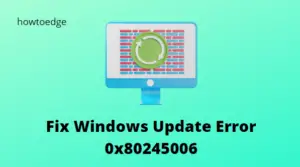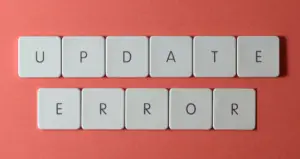Microsoft has always considered Windows Update as a useful tool to release new features and resolve issues. But what if the update itself causes problems? Well, this is something that many users have complained about. When they try to install the latest build or update their PC, they receive the error 0x800700a1 on Windows 11/10. Read this article if you are also experiencing such an issue on your device.
What Causes Windows Update Error 0x800700a1?
Error 0x800700a1 generally occurs when downloading the latest Windows updates. Here are some common causes, which can lead to this error code:

- Multiple pending updates are often the cause of Windows update errors.
- You are most likely to encounter this error if you disable important Windows update services.
- Another major cause of update problems is corrupted Windows update files.
- Hardware and driver conflicts can also trigger error messages.
You now know why the error message is appearing, so let’s look at how you can fix it.
How to Fix Update Error 0x800700a1 on Windows 11/10
There are a number of reasons why Windows update errors may appear during the installation process. The most common error message is often accompanied by an error code, as well as a brief explanation of how to resolve it. The below solutions may be helpful for you if you encounter the update error 0x800700a1.
1] Check the Windows Update
If you’re looking to resolve a technical issue, make sure you run the Windows update first. This is often caused by multiple updates queued up. If this is the case, restart the system and perform the update process to fix the issue.
2] Run SFC Scan
The most common cause of this error type in Windows 11/10 is corrupt system files. If you continue to have problems with corrupted files, you may open Command Prompt as administrator and then run the following code on it –
sfc /scannow

This tool will take 10-15 minutes to find and repair missing and corrupt system files and folders. Wait for this tool to reach 100%, and when this is over, restart your computer.
3] Free up some drive storage space
There is often a lack of space on the hard drive that leads to update errors. While Windows automatically reserves space for updates, there can still be issues if there isn’t enough hard drive space. For this reason, make sure you have enough space on your primary partition for updating
4] Run the Windows Update Troubleshooter
An update troubleshooter tool is integrated into the latest operating system to assist with the diagnosis and resolution of update errors. Follow the steps below to run the Windows update troubleshooter.
- Right-click on Start and select Settings from the menu list.
- Then select the System tab from the left pane.
- Scroll down and select Troubleshoot.
- Select Other troubleshooters on the next page.

- Click the Run button next to Windows Update.
There will be a troubleshooter window that pops up and it will look for any issues. When it finds the issue, it will suggest possible solutions.
5] Perform Clean Boot
Several third-party apps can interfere with Windows Update and cause trouble for you. To solve the problem, you should perform Clean Boot and try downloading the update again. Upon installing the update, you must enable every update manually. Once you identify the culprit, simply removing that program will fix the problem.
- Click on Start, type msconfig, and press the Enter key.
- When the System Configuration window opens, go to the General tab.
- Select Selective startup and then tick Load system services.
- Now switch to the Services tab.

- Mark Hide all Microsoft services.
- Then click the Disable all option. This will disable all listed third-party services at startup.
- Click the Apply button.
- Now switch to the Startup tab.
- Click the Open Task Manager button.
- Right-click on each of the unwanted startup programs, and then choose Disable.
- Exit the Task Manager.
- In the System Configuration window, click Apply > OK.
You’re done. Reboot your computer, and you can now download the update.
6] Restart the Windows Update service
In order to download updates from Microsoft servers, you must have certain services enabled. Therefore, if you are still receiving the error code, you will need to restart the Windows Update service. Here are the steps you need to follow to enable Windows Update.
- Open the Run dialog box using the Windows+R keys.
- In the text box, enter services.msc and click the OK button.
- Scroll down to Windows Update, right-click on it, and select b.
- Make sure the Startup type is set to Automatic.
- Under Service status, click Start.
- Then click Apply and OK.
You must do the same thing with each of these services as well:
- Background Intelligent Transfer Service.
- Cryptographic Service.
- Windows Update Medic Service.
7] Disconnect all unnecessary peripherals
A conflict between hardware and a driver can cause the update error to appear. In this case, you can check if your system is equipped with any unnecessary peripheral devices, such as a webcam, microphone, and scanner. If so, please unplug them and see if it solves the problem.
8] Run the DISM Tool
Sometimes, a damaged component in a system can also cause the Windows update error 0x800700a1. If this occurs, you need to run DISM to repair damaged system components and see if it solves the issue.

- Run the Command Prompt as an administrator.
- Now execute the following command:
DISM.exe /Online /Cleanup-image /Restorehealth
It could take a while for Command Prompt to complete the scan. Once the scan is complete, restart your PC to begin the download.
9] Clear the Software Distribution Folder
The SoftwareDistribution folder contains all the information related to Windows updates. However, if this folder becomes corrupt for any reason, Windows updates will not work. To resolve this issue, you must clear the contents of the SoftwareDistribution folder. Let’s go over how to do that.
- Run the Command Prompt as an administrator.
- Type in the below commands and press Enter.
net stop wuauserv net stop bits
- Now press the Windows+E keys to open File Explorer.
- Browse to the following location.
C:\Windows\SoftwareDistribution
- On the next page, press the Ctrl+A keys to select everything inside the SoftwareDistribution folder.
- Then right-click on it and select Delete.
- If you encounter the message, The file is currently in use, restart the system and then delete the folder content.
- Again open the Command Prompt as an administrator.
- Type in the following command and press Enter.
net start wuauserv net start bits
- Now restart your computer and check if it solves the problem.
Read Next:



